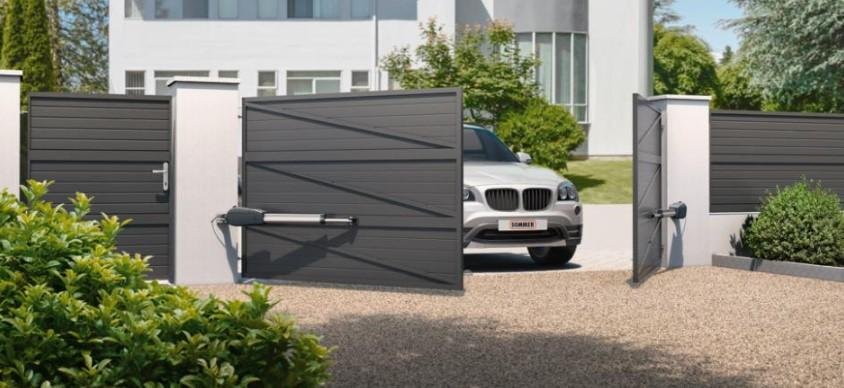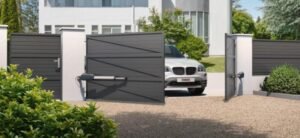Installing a gate provides security, privacy, and style, enhancing both the functionality and curb appeal of your property. Gates act as the first line of defense, preventing unauthorized access while creating a welcoming entrance. Whether for a residential or commercial property, choosing the right type of gate and ensuring a proper installation are critical steps to achieving long-lasting security and aesthetic appeal.
1. Benefits of Installing a Gate
Adding a gate to your property brings a host of benefits, from improving security to adding value to your home. Here’s a look at some of the top advantages:
- Enhanced Security: Gates serve as a physical barrier, deterring intruders and protecting your property. Automated gates, in particular, add an extra layer of security by restricting entry to authorized individuals only.
- Increased Privacy: A well-designed gate can shield your property from unwanted attention. It limits visibility, allowing you to enjoy your personal space without interruptions from neighbors or passersby.
- Improved Property Value: A gate adds visual appeal and practical value to your property, making it more attractive to potential buyers. A secure and private home is often a priority for many homebuyers.
- Child and Pet Safety: For families with young children or pets, gates provide an added layer of safety by keeping loved ones within the property’s boundaries.
2. Types of Gates for Various Needs
There are numerous gate options available, each suited to different purposes and aesthetic preferences. Choosing the right one depends on your specific needs, style, and property layout. Here are a few popular types:
- Swing Gates: These gates open like a door, swinging inward or outward. Swing gates are popular for their classic design and can be single or double-leafed, making them suitable for both small and large entrances.
- Sliding Gates: Sliding gates operate by moving horizontally along a track. They are ideal for properties with limited space since they do not require space to swing open. Sliding gates are often chosen for their practicality in narrow driveways or commercial premises.
- Bi-Fold Gates: Bi-fold gates are divided into sections that fold upon opening. They are compact and perfect for areas with limited space. Bi-fold gates are often used for residential properties and can be designed with various materials and styles.
- Automated Gates: Automated gates offer convenience and enhanced security, allowing access with a remote, keypad, or smartphone. They are available in swing, sliding, and bi-fold styles, making them versatile for various property types.
- Pedestrian Gates: These smaller gates are used specifically for foot traffic, often complementing larger vehicle-access gates. Pedestrian gates are perfect for creating a separate entrance for people while maintaining a secure boundary.
- Driveway Gates: Driveway gates are typically larger and designed to accommodate vehicles. They can be automated or manual and come in various styles, from elegant wrought iron to modern steel.
3. Key Considerations for Gate Installation
When planning a gate installation, certain factors must be taken into account to ensure your gate provides maximum security, functionality, and aesthetics.
Location and Space
Evaluate the available space for the gate and how it will operate within that space. For example, swing gates require room to open fully, whereas sliding gates are ideal for areas with limited clearance. Determine whether the gate will be installed at the entrance to a driveway, garden, or commercial lot to select the best design.
Material Selection
Gate materials affect durability, maintenance requirements, and overall look. Common materials include:
- Wrought Iron: Durable and stylish, wrought iron gates are popular for their classic look and strength. They can be intricate in design but may require maintenance to prevent rust.
- Steel: Steel gates are known for their strength and security. They are resistant to harsh weather conditions, making them suitable for both residential and commercial applications.
- Wood: Wooden gates offer a warm, traditional appearance. However, they may require regular treatment to protect against moisture and pests.
- Aluminum: Lightweight and rust-resistant, aluminum gates are a good choice for coastal areas. They are low-maintenance and can mimic other materials, such as wood or iron.
Style and Design
The style of the gate should complement the architecture of your property. Modern gates, for example, tend to feature clean lines and minimalist designs, while traditional gates might have decorative elements and ornate patterns. Customization options such as color, height, and pattern allow you to create a gate that matches your aesthetic vision.
Security Features
Security is a top priority for most gate installations. Here are some security-enhancing options:
- Locks: Choose a secure locking system, such as a deadbolt or an electronic lock. Some automated gates include built-in locks for added security.
- Cameras and Intercoms: Installing cameras or an intercom system allows you to monitor and communicate with visitors before granting access.
- Motion Sensors: Motion sensors can be added to alert you to movement near your gate, enhancing security further.
- Alarm Systems: Connecting your gate to your home’s alarm system can provide an extra layer of protection by triggering alarms if forced entry is attempted.
4. The Gate Installation Process
Installing a gate requires careful planning and precision to ensure proper alignment, stability, and functionality. Here’s an overview of what to expect during installation:
Preparation and Site Assessment
A site assessment is the first step in the installation process. Professionals evaluate the area to identify any obstacles and ensure the space is suitable for the chosen gate type. This step includes taking accurate measurements to prevent installation errors.
Foundation and Posts
Most gates require sturdy posts or a foundation to support their weight and provide stability. The foundation may include concrete footings for heavy gates, particularly. This involves attaching the gate to a track, while swing gates are attached to the posts with heavy-duty hinges. Professionals take care to align the gate precisely to prevent any operational issues.
Automating the Gate (Optional)
For automated gates, motors and control systems are installed. This may involve wiring, setting up remote access systems, and integrating safety sensors. Automated gates require testing to ensure smooth operation and functionality.
Testing and Final Adjustments
After installation, the gate is tested to check for smooth opening and closing. The installer ensures all locking mechanisms, safety sensors, and additional features are functioning correctly.
5. Maintaining Your Gate for Longevity
Regular maintenance keeps your gate looking and functioning well over time. Different materials have unique maintenance needs:
- Cleaning: Wipe down metal gates periodically to prevent dirt buildup, which can cause rust.
- Lubricating Moving Parts: Hinges and other moving parts benefit from occasional lubrication, which helps prevent squeaking and keeps the gate operating smoothly.
- Inspecting for Wear and Tear: Regularly inspect the gate for signs of damage or wear. Look for loose bolts, rust, and any alignment issues, addressing these problems early to avoid costly repairs.
- Checking Automation Systems: For automated gates, test the motor, sensors, and remote control regularly.
Conclusion: Choosing and Installing the Perfect Gate
Gate installation is a valuable investment in security, privacy, and curb appeal. With a wide variety of materials, styles, and automated options available, you can find the perfect fit for any property.






More Stories
Elevate Your Bathroom with Brass Bathroom Accessories
Choosing Quality Aluminum Windows for Homes
The Complete Guide to Bifold Doors